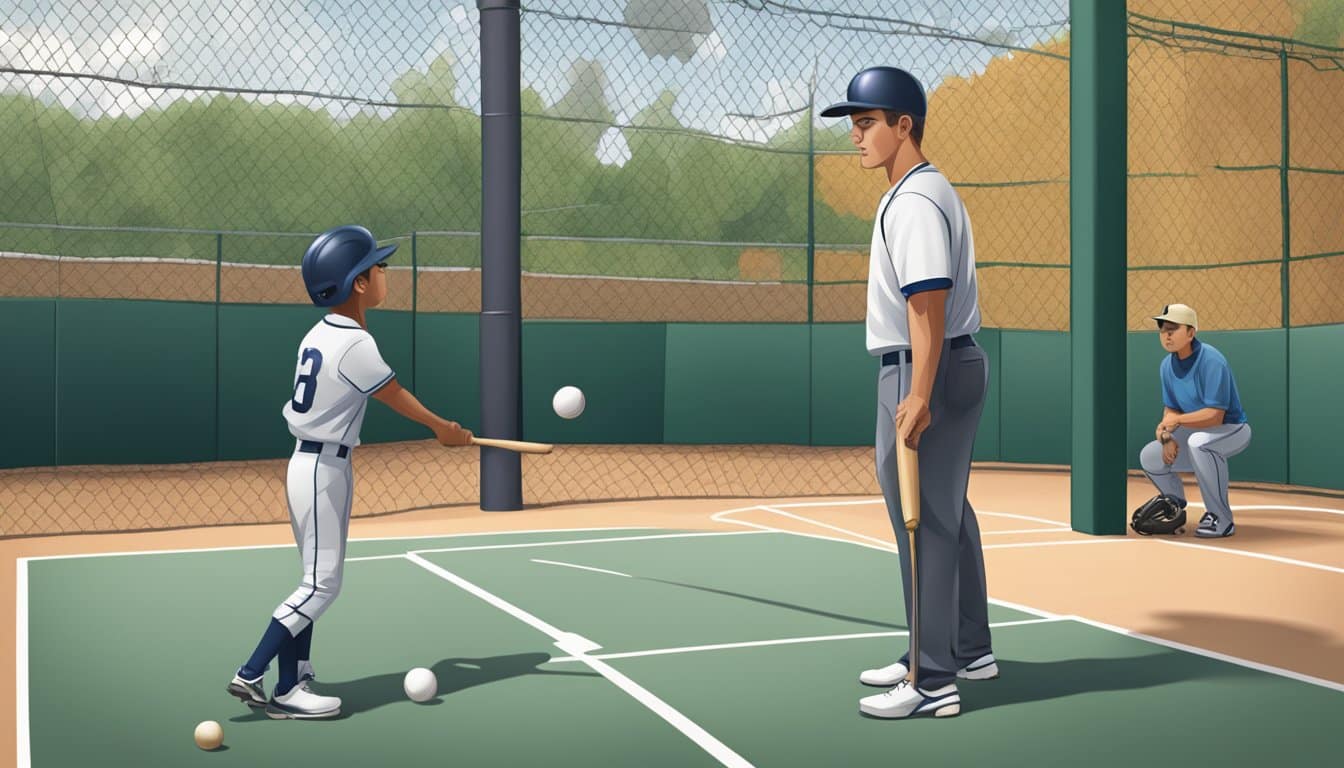Batting tees provide an accessible and effective way for young baseball players to practice hitting. They allow for a focus on form and consistency, two critical factors in developing a solid batting technique. By isolating the swing and removing variables such as pitch speed and location, players can concentrate on the mechanics of their stance, swing path, and follow-through.
Young players benefit from a structured approach to batting tee exercises that systematically enhance their skills. These exercises can be tailored to address the early stages of learning the basics, as well as more sophisticated techniques as the player’s abilities advance. Strength and accuracy are core components of these drills, helping players to build power and precision in their swing.
Key Takeaways
- Batting tee exercises can significantly improve young players’ swing mechanics.
- A structured practice routine enhances strength, accuracy, and advanced hitting techniques.
- Regular drills promote physical conditioning and strategic play development while ensuring safety.
Understanding the Basic Batting Tee Mechanics
https://www.youtube.com/watch?v=XwHLwDVRjjU&embed=true
Mastering the basic mechanics of hitting off a batting tee is essential for young players to build a solid foundation in baseball or softball. This section will cover crucial aspects such as swing techniques, stance, and the generation of power through the lower body.
Swing Basics and Body Movements
The swing begins with the stance. Players should maintain a balanced and comfortable stance, with feet shoulder-width apart. The body movements are critical, as they need to remain fluid throughout the swing. A pivotal swing mechanic is the rotation of the torso, aligning the bat’s path with the incoming ball for an effective contact.
- Stance: Shoulder-width apart, knees slightly bent, weight on the balls of the feet
- Body Movement: Smooth, with a focus on rotational torque
Stance and Grip Fundamentals
The grip is an integral part of the swing mechanics. Players should hold the bat with both hands close together, knuckles aligned, ensuring the hands are neither too tight nor too loose. This promotes both control and the quickness of the swing. The stance should be comfortable, allowing for a full range of motion through the swing.
- Grip: Hands close, aligned knuckles, secure yet relaxed
- Stance Fundamentals:
- Comfortable and balanced
- Enables full range of motion
Using the Legs and Hips for Power
The legs and hips are the driving force behind a powerful swing. By bending the knees and utilizing the hips to initiate the swing, players can generate significant power. The movement should involve a smooth transfer of weight from the back leg to the front, culminating in the explosive rotation of the hips.
- Legs: Initiate movement with slight knee bend
- Hips: Drive the swing with explosive rotation
| Body Part | Role in Mechanics |
|---|---|
| Legs | Foundation and initiation of the swing |
| Hips | Generate power through rotational force |
Practical Drills for Effective Hitting
https://www.youtube.com/watch?v=fPRAqPcEPYA&embed=true
Honing the skills required for proficient batting involves repetitive practice with a variety of drills. These exercises help in building muscle memory and refining the different aspects of a player’s swing.
The Standard Tee Drill for Swing Consistency
Position the batting tee at belt level in the center of the player’s stance. The batter should focus on hitting the ball with the sweet spot of the bat, ensuring a level swing through the strike zone. Repeated practice of this drill enhances swing consistency and helps players to better gauge their contact with the ball.
Inside and Outside Pitch Tee Drills
For inside pitches, place the tee close to the batter’s body and slightly forward in the stance. The goal is to contact the ball out in front, allowing the player to drive the ball effectively without pulling off the swing. For outside pitches, set the tee further back and away from the hitter. They should aim to hit the ball at the opposite field, emphasizing on driving through the ball with a full extension.
-
Inside Pitch Focus
- Tee Placement: Close and forward
- Goal: Contact out in front
-
Outside Pitch Focus
- Tee Placement: Back and away
- Goal: Drive to opposite field
Tee Drills for Improving Contact
Using a batting tee, players can perform a variety of contact drills. One effective exercise is to alternate hitting the top half and bottom half of the baseball to practice creating backspin or topspin. This can be especially helpful in developing the ability to hit line drives and control the trajectory of the ball by making precise contact at different points on the ball’s surface.
- Contact Drill Tips
- Goal 1: Hit top half of the ball for backspin
- Goal 2: Hit bottom half for topspin
Developing Strength and Accuracy
https://www.youtube.com/watch?v=VBGjLcNTbLw&embed=true
To optimize a young player’s batting potential, targeted exercises are crucial for augmenting both muscle memory and accuracy, which are integral to a powerful and precise swing. Strength training tailored for baseball ensures the development of relevant muscle groups.
Exercises for Building Muscle Memory
- Tee Drills with Variation: Players should start with the basic tee drill, hitting balls off a stationary tee to enhance their swing mechanics. They can then introduce variations, like moving the tee to different positions to mimic pitches across the strike zone.
- Soft Toss: A coach or another player tosses the ball softly towards the batter, who focuses on consistent swing motion and contact quality. This exercise translates to improved muscle memory for varying pitch locations.
Drills for Enhancing Batting Accuracy
- Target Practice: Set up a net with marked targets and have players aim their hits accordingly. This encourages a focus on hitting precision.
- Bunting Drills: Although bunting is different from full swings, it’s an excellent way to teach hand-eye coordination and control, both vital for batting accuracy.
Strength Training for Young Baseball Players
- Fundamental Exercises: Incorporate basic strength training exercises such as push-ups, planks, and squats to build core and upper body strength pertinent to a powerful swing.
- Resistance Training: Utilize resistance bands or light weights to perform baseball-specific movements that mimic the batting swing, strengthening the exact muscles used on the field.
Tactics for Advanced Hitting Techniques
https://www.youtube.com/watch?v=SbQgOR8bubg&embed=true
In pursuit of heightened batting prowess, young players can employ specific tactics using a batting tee to refine their timing and power. These methods demand focus and a deliberate practice regimen.
Adjusting Timing and Rhythm with the Tee
Young hitters can benefit greatly from using the tee to improve their timing and rhythm. To accomplish this, they should focus on:
- Variable tee placement: Position the ball slightly in front of, over, or behind the ideal contact point. This simulates different points of contact and encourages the hitter to adjust their stride and swing timing.
- Pause-and-hit drills: Incorporate a pause at the peak of the load phase to develop a sense of balance and momentum control, before committing to the swing.
Developing a consistent stride and load phase trains the body to maintain balance and explosive energy throughout the swing.
Mastering the Art of the Power Swing
For a truly powerful swing, players must unite mechanics with physical strength. This is achieved through:
- Weight transfer drills: Stress the importance of moving the body weight from the back foot through the ball to generate force.
- Exaggerated follow-through: Encourage practicing an extended follow-through to understand the full range of motion required for power.
This focus on kinetic linkage ensures the entire body works in harmony, translating to more powerful hits.
Hitting Techniques for Different Pitch Speeds
To tackle various pitch speeds, batters can:
- Slow-motion swings: Execute the swing in slow motion to isolate and understand each movement’s impact on the bat’s path and velocity.
- Tee height drills: Change the height of the tee to mimic different pitch trajectories and practice adjusting the swing plane accordingly.
By simulating slower and faster pitches, hitters learn to adapt their hitting techniques and maintain effectiveness against diverse pitchers.
Field-Specific Exercises
https://www.youtube.com/watch?v=SkLvrOJQQHc&embed=true
Utilizing a batting tee for fielding practice aids in developing consistent ball contact skills for infielders and outfielders. This section offers specific drills tailored to enhance a young player’s handling of ground balls and fly balls, fundamental aspects of fielding.
Infield and Outfield Ground Ball Drills
For infielders, they can improve their ground ball fielding by:
- Positioning the tee at knee height and gently tapping the top of the ball to simulate a ground ball.
- Focusing on proper footwork: They should approach the tee, tap the ball and field it, ensuring they remain in a balanced position to throw.
Outfielders can adapt this drill by:
- Increasing the distance from the tee: After tapping the ball, outfielders should work on charging the ball and priming their body for a long throw.
Fly Ball Practice with a Batting Tee
Simulating fly balls with a batting tee requires players to:
- Place the ball on the tee and hit it with an upward swing to initiate a fly ball trajectory.
- Infielders should concentrate on tracking the ball and positioning themselves under the catch.
- Outfielders must focus on catching over-the-shoulder fly balls. They should hit the ball, drop the bat, and run to the landing spot, maintaining eye contact with the ball.
Using batting tees in these ways ensures young players get ample chances to cultivate their fielding abilities in a controlled environment.
Strategic Play Development
https://www.youtube.com/watch?v=ucbT_4lLhj8&embed=true
Incorporating batting tee exercises into practice sessions is essential for young players. These drills enhance their proficiency in game-specific scenarios, providing a strong foundation for strategic play in both baseball and softball.
Running Bases with Effective Tee Use
To simulate in-game pressure, young athletes should practice hitting from a tee and immediately run bases. Timing is crucial for this drill.
- Start with the tee at home plate.
- The player hits the ball and sprints to first base, focusing on quick acceleration.
- Coaches should use a stopwatch to record the time from the hit to touching the base.
This exercise benefits players by improving their quickness in game situations, making them more efficient base runners.
Situational Hitting and Strategic Game Play
Players must understand different hitting strategies and how to execute them using a batting tee.
-
Hit-and-Run Drill:
- Position the tee where the pitch would ideally be placed for this play.
- The batter hits the ball to a designated field area, promoting an advanced runner.
-
Opposite Field Hitting:
- The tee is adjusted to encourage hitting the ball to the opposite field.
- This work on ball placement in the field develops the skill to exploit defensive weaknesses during a game.
These focused drills build a player’s ability to formulate and execute hitting plans, an essential component of softball and baseball strategy.
Physical and Mental Conditioning
https://www.youtube.com/watch?v=PqvLXKnbvro&embed=true
Creating an effective training routine for young baseball players involves both sharpening their mental focus and enhancing their physical capabilities. The right batting tee exercises can lay the groundwork for these essential skills.
Promoting Mental Focus with Hitting Drills
Mental focus is crucial for a batter’s success. Concentration on each swing can be honed through repetitive hitting drills. One method involves the use of color-coded balls to promote split-second decision-making. For example, they must only hit balls with a certain color, teaching them to quickly identify and react to different pitches.
-
Drill 1: Soft Toss Color Recognition
- Equipment: 4 different color balls
- Procedure: Toss each ball, calling out the color late, forcing the batter to focus.
-
Drill 2: Randomized Tee Placement
- Equipment: Batting tee
- Procedure: Place the ball randomly on different parts of the tee, enhancing focus on ball placement.
Physical Conditioning Through Tee Exercises
To build physical conditioning, specific tee exercises are beneficial. They target muscle memory and increase the player’s hitting power. Tee drills should be varied to work different muscle groups and keep practices engaging.
-
Drill 1: Inside Pitch Hitting
- Equipment: Batting tee, baseballs
- Procedure: Set up the tee inside the hitting zone, strengthening the wrists and forearms.
-
Drill 2: High and Low Tee Drills
- Equipment: Adjustable batting tee
- Procedure: Adjust the tee to high and low positions, promoting adaptability and full-body coordination.
These exercises will not only build a player’s fundamental techniques but also condition them for the physical demands of the game and improve their mental acuity in the batter’s box.
Implementing a Youth Baseball Practice Routine
https://www.youtube.com/watch?v=8mr0tfF72LY&embed=true
Establishing an effective practice routine is fundamental to the development of young baseball players. Coaches should focus on creating a dynamic schedule that is both consistent and adaptable, ensuring practices are not only productive but also enjoyable for the participants.
Creating a Dynamic Practice Schedule
Daily Focus Areas: Coaches should outline each day of practice with a clear objective, whether it’s hitting accuracy, fielding skills, or base running tactics. A sample weekly schedule could look like this:
- Monday: Hitting mechanics
- Tuesday: Defensive positioning
- Wednesday: Base running strategies
- Thursday: Team communication drills
- Friday: Review and scrimmage game
Particular emphasis should be placed on repetition and progression, allowing players to build on the skills learned in previous sessions.
Incorporating Fun and Engaging Drills
To keep young athletes engaged, practices should blend fundamental skill-building with entertaining drills that encourage spirited participation.
Drill Examples:
- Hit the Bucket: Place a bucket at second base and have players practice hitting it from home plate, fostering accuracy in hitting.
- Fielding Relay: Set up a relay course where players must field and quickly transfer the ball to various points, incentivizing swift and precise fielding.
- Base Race: Engage players in a race around the bases to encourage speed and agility, while also teaching proper sliding techniques.
These drills should be rotated regularly to maintain a fresh and stimulating environment, thereby ensuring that young players remain focused and excited about their practice routine.
Safety Tips and Maintenance
Effective and safe batting practice is reliant on consistent maintenance of equipment and adherence to safety guidelines. This section explores the necessary steps to ensure both components are addressed.
Ensuring Safety During Batting Practice
Personal Protective Gear: Players should always wear a helmet during batting practice to safeguard against head injuries. It’s crucial to use helmets that meet proper safety standards.
Equipment Inspection: Before practice commences, inspect the batting tees for any signs of wear or damage. Broken or unstable tees must be replaced immediately to prevent accidents.
Surrounding Area: Ensure the area around the batting tee is clear of obstacles and other players to reduce the risk of injury from misplaced swings or deflected balls.
Supervision: Young players should be supervised by an adult who can maintain a safe environment and provide immediate assistance if needed.
Maintaining and Choosing the Right Batting Tees
Regular Examination:
- Check batting tees regularly for stability; loose or missing parts can lead to improper use and safety hazards.
- Look for signs of deterioration in the tee’s material, especially if it’s a rubber top like the Tanner Tee, which can weather over time.
Proper Storage:
- Batting tees should be stored in a dry, cool place to prevent warping or mold growth.
- Collapsible models should be retracted and secured to prolong their lifespan and make storage more efficient.
Choosing Quality Equipment:
- Select tees with a solid base to avoid tipping and enhance durability.
- Consider tees with adjustable heights, such as the Tanner Tee, to accommodate various age groups and sizes for optimal practice and growth.
Frequently Asked Questions
https://www.youtube.com/watch?v=tBBjgzEGfRw&embed=true
This section addresses common queries about batting tee exercises for young players, offering specific drills and techniques to enhance their batting skills.
What are effective hitting drills for 8 to 12 year old baseball players?
Young players within this age range can benefit significantly from the “Fence Drill,” which teaches them to keep the bat close to their body, leading to a more compact swing. The “Soft Toss Drill” is also excellent for hand-eye coordination, where a coach or parent gently tosses balls to the hitter from the side.
How can you increase a young player’s hitting power in baseball and softball?
To increase hitting power, young players should work on lower body strength and core stability. Drills like the “Tee Twist” exercise, where they focus on rotating their trunk during the swing, can increase torque and thereby power. Additionally, proper weight transfer through the legs during the swing is crucial for power hitting.
What are age-appropriate batting drills for young cricketers?
For young cricketers, the “Straight Drive Drill” off a tee helps them in mastering the art of hitting along the ground in the V. Another drill is the “Pull Shot Drill” where they learn to play horizontal bat shots effectively against short-pitched deliveries.
In what ways can hitting off a tee improve batting skills for youth players?
Hitting off a tee aids in isolating specific parts of a young player’s swing since there’s no pitch speed or movement to contend with. It allows players to work on swing path, point of contact, and follow-through, helping to build muscle memory for a consistent swing.
What techniques can help improve a child’s batting timing and coordination?
A child’s batting timing and coordination can be improved with the “Color Ball Drill,” where a coach can mark balls with different colors and call out which one to hit as they’re pitched or placed on the tee. This drill emphasizes quick decision-making and timing. Furthermore, repetitive practice of swinging at various ball heights on the tee can enhance overall coordination.
Can you provide some youth baseball hitting tips to boost performance at the plate?
For boosting performance at the plate, coaches should encourage youth players to keep their eyes on the ball and maintain a balanced stance with even weight distribution. Practicing the stride and swing to ensure a smooth and controlled motion can also contribute to better performance during games.









